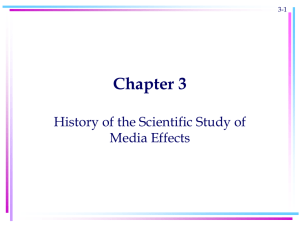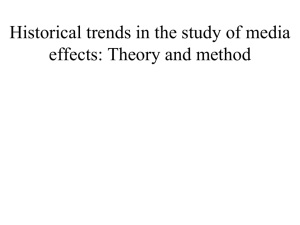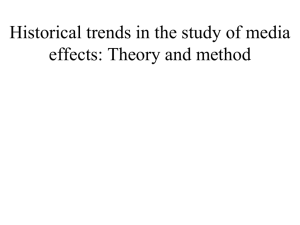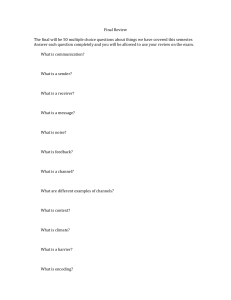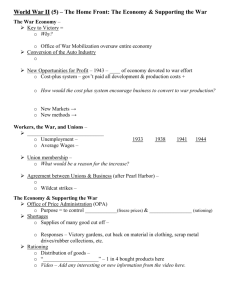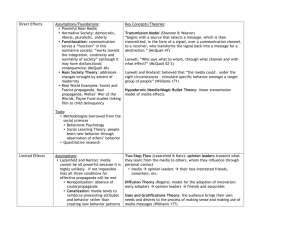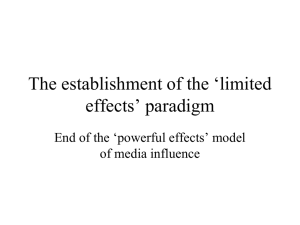Media effects
advertisement
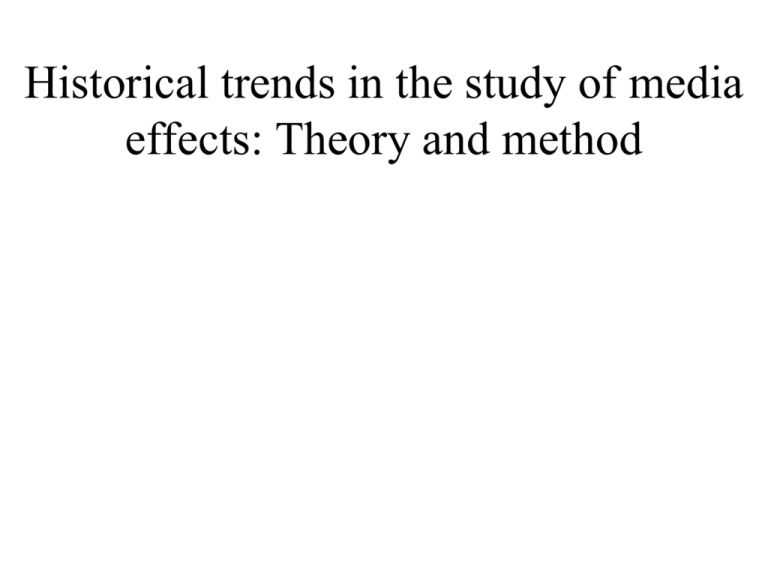
Historical trends in the study of media
effects: Theory and method
Historical change
• Late 19th Century till 1940s saw a fear of
powerful media effects
• 1940s through early 1970s was the era of
‘limited effects’
• From 1980s media studies splinter into a
wide variety of approaches, with the
mainstream view moving toward partial and
mediated effects
Early
th
20
century
• Professionalization of advertising
• Development and growth of new mass
media technologies
• The Great War
– England and the U.S. develop propaganda on a
large scale
– After the war, Bernays and others claim to be
able to ‘engineer consent’
Popular fears of mass manipulation
• Sudden and rapid growth of
mass media
– Newspapers
– Periodicals
– Movies
– Radio
Social fears
• Growth and increasing sophistication of
persuasion ‘professions’
– Advertising
– Public relations/propaganda
• Massive WWI propaganda output
– Exorbitant post-warclaims of efficacy post-war
by Creel Committee members
• Creel
• Bernays
Committee on Public Information
• Woodrow Wilson re-elected President
in 1916
– Ran on a platform emphasizing “He kept
us out of war”
• Within a year, was leading the country
into war with Germany
• Created the Committee on Public
Information (CPI) on April 13, 1917
• "Lead this people into war, and they'll
forget there was ever such a thing as
tolerance. To fight, you must be brutal and
ruthless, and the spirit of ruthless brutality
will enter into the very fibre of national life,
infecting the Congress, the courts, the
policeman on the beat, the man in the
street."
Edward L. Bernays
• Freud’s nephew
– Attempted to apply psychoanalysis to
propaganda
• Used psychological research methods,
advertising methods to “manufacture
consent”
• Tireless promoter of PR as way to control
public opinion
Lasswell’s study of propaganda
• Interested in the application of symbol
manipulation to influence psychological
unconscious
– Nationalism and ego-involvement
– Manipulation of emotions via propaganda
– Tried to take a distanced, ‘uninterested’ position toward
propaganda
• Identified goals and methods of propaganda
• Harold D. Lasswell, Propaganda Technique in the
World War (New York: Knopf, 1927).
Creel Committee Emphases in their
propaganda
• Emotional Appeals
• Demonization
• The War to End All Wars
• Dishonesty
• "Propaganda in the broadest sense is the
technique of influencing human action by
the manipulation of representations. These
representations may take spoken, written,
pictorial or musical form."
• "Some of those [persons who participated in
World War I] who trusted so much and hated so
passionately have put their hands to the killing of
man, they have mutilated others and perhaps been
mutilated in return, they have encouraged others to
draw the sword, and they have derided and
besmirched those who refused to rage as they did.
Fooled by propaganda? If so, they writhe in the
knowledge that they were the blind pawns in plans
which they did not incubate, and which they
neither devised nor comprehended nor
approved."{2}
• 2. Harold D. Lasswell. Propaganda Technique in the World War. First
edition, 1927. Reprint. New York & London: Garland Publishing, Inc.,
1972. Page 8.
Payne Fund Studies: The effects
of movies on children
Conducted in the late 20's and early 30's
• this series of studies occurred in two categories:
1. assess content of films and audience size and
composition (Dale)
2. audience effects of themes and messages
a. acquisition of information (Holaday and Stoddard)
b. attitude change (R.C. Peterson and Thurstone)
c. stimulating emotions (Dysinger and Ruckmick)
d. harming health (Renshaw, Miller and Marquis)
e. eroding moral standards (C.C. Peters)
f. influencing conduct (Shuttleworth and May, Blumer and
Hauser)
Payne Fund
• Conclusions:
– Movies affected the way children dressed, their
expectations with regard to sex, led to fear and
lost sleep.
– Movies also provided some positive role
models, innocent entertainment, etc.
– Some disconfirmation of the worst fears found
in popular culture
The War of the Worlds
• An accidental occurrence seemed to
validate some of the worst fears about mass
society and the power of the newest mass
medium, the radio
• Orson Welles’ Mercury Theater of the Air’s
broadcast of an adaptation of H.G. Wells’
War of the Worlds on Halloween eve, 1938
Research on the broadcast
• The invasion from Mars: A study in the
psychology of panic (1940: Princeton
University)
– Cantril, Gaudet, Herzog
The establishment of the ‘limited
effects’ paradigm
End of the ‘powerful effects’ model
of media influence
Columbia School
• Paul Felix Lazarsfeld emigrated from Austria to the U.S. in
the 1930s.
– A mathematician
– Interested in the application of mathematics, especially the new
statistics, to study of social problems
• Sets up research programs at Princeton (Radio Research
Bureau) and at Columbia (Bureau of Applied Social
Research) that combine study of practical problems with
academic methods of research
– Model that would be followed by the field from then on.
• First studies focus on audience size, reactions to and use of
radio programming
– As well as a wide array of social concerns that were not
communication-oriented
The People’s Choice
• Lazarsfeld, Berelson, and Gaudet
• Study of the 1940 presidential election in Erie
county, Ohio
• 20th Century--strong, commercially successful
newspapers, radio, magazines, that had the
ability to say what they wanted to in Western
European countries
• The research comes from vague ideas of what
is worth studying
Research Questions
1.
How do people decide to vote as they
do?
2. What were the major influences on
them?
• "Social characteristics determine political
preference."
Results
• Lazarsfeld could predict with 76% accuracy
which candidate someone would vote for based on
his demographics. That was better than the people
themselves could predict.
– Prediction is taken as the criterion of validity
– "Cross-Pressures"
• Opinion Leaders (21%)
– ("Have you tried to influence someone on a political
issue recently?"; "Has anyone asked your advice
recently on a political issue?")
– opinion leaders were thought to be a relatively small
group of influential people
• Lacked evidence of actual influence
Media influence
Whenever a person in the sample changed
his/her vote intention, the interviewer asked
why:
• Democrats mentioned radio most often
(30% vs. 20% for newspapers)
• Republicans mentioned newspapers (31%
vs. 17% for radio).
• Over half the voters said the media had the
most important impact, 2/3 said news media
were “helpful”
• “Two-step flow”
• Conclusion--interpersonal communication
most important
• Those most likely to be predisposed to vote
Democratic were exposed to more pro-Democratic
propaganda
– the analogous situation was true for Republicans
• Lazarsfeld decided this showed ‘selective
exposure’--those who were predisposed to vote
one way or another chose to expose themselves to
propaganda that was positive toward the preferred
party
When did they make up their
minds?
• 1/2 made up their minds before May
• Once they knew who won the nomination,
another 1/4 made up their mind
• 1/4 made up their mind between the
nomination and the election
• Columbia did another campaign study in
1948, then turned to other concerns
– Voting, by Berelson, Lazarsfeld and McPhee
Impact of the studies
• The studies set the parameters of political
communication research for over a decade
and still influence the field now
• Major studies of elections did not even ask
about media for several election cycles
Hovland
• Experiments on mass communication: Persuading
the American soldier in World War II
– Hovland, Lumsdaine and Sheffield (1949)
• Studied the impact of showing Frank Capra’s
propaganda films in “Why We Fight” series to
American soldiers in a training camp
– Many were draftees and did not want to fight
• Attempted to measure the effects of movies on
information acquisition and modification of
soldiers' interpretations and opinions, attitudes
toward allies, and motivation
Why We Fight
• Films from the series included in the study:
Prelude to War, The Nazis Strike, Divide
and Conquer, The Battle of Britain
Battle of Britain
• Men in two camps--some were exposed to a
film, some not
– 2100 in one camp (before/after control group)
– 900 in another camp (before/after control
group)
– 1200 (after-only control group)
– Sampling by company units
• Units were matched on several demographic
variables
The Battle of Britain
• Before and after questionnaires were
slightly different
– Tried to distract men from wondering why they
were answering twice by writing “revised” on
the questionnaire
• One week between exposure and the second
measure
• Anonymity was assured
Results
• The movies had a significant impact on
factual knowledge
• Ex. Why weren’t the Germans “successful
at bombing British planes on the ground”?
• Ans. “because the British kept their planes
scattered at the edge of the field”
• Experimental group: 78% correct
• Control group:
21% correct
Results: Learning from films
dependent upon education
60
50
40
30
Test Score
20
10
0
Grade School
High School
College
Results
• Opinions and interpretations
– Effects were not as great
– “the heavy bombing attacks on Britain
were an attempt by the Nazis to . . .”
– Answer: “invade and conquer England”
• Experimental group: 58%
• Control group:
43%
Results
• General attitudes
– Effect was slight
– “Do you feel that the British are doing all
they can to help win the war?”
• Experimental group 7% greater than control
• In many cases, only 2-3% positive difference
was found
Results
• Morale
– Almost no impact at all
– Preference to serve overseas rather than in the
United States
• Experimental group 42%
• Control group
39%
– Unconditional surrender by Nazis is an important
war aim
• Experimental group 62%
• Control group
60%
“Sleeper effect”
• 9 weeks after exposure
– Factual material was forgotten
• Retained only about 50% of factual items that 1-week groups
remembered
– On 1/3 of opinion issues, the long-term group showed
less change
– However, on more than half of the fifteen issues under
study, the long term group showed greater change than
the short-term group
One-sided v. two-sided argument
• Radio presentation saying war would be
lengthy
– Presented either as one-sided argument or with
additional 4 minutes discussing view that it
would be short
– Before/after with control group
Results
• One-sided argument more effective with soldiers
who:
– Initially supported the idea that it would be a lengthy
war
– Had not completed high school
• Two-sided arguments more effective with soldiers
who:
– initially felt the war would be short
– had a high school degree education or greater
Yale School
• Hovland et al. set up Yale School of
research on persuasion
• Studied the effect of:
–
–
–
–
Source characteristics
Message characteristics
Order of presentation
Psychological characteristics of audience
Source characteristics
• Credibility
– Topic: Atomic submarines
• Sources: J. Robert Oppenheimer/Pravda
– Topic: Future of Movie Theaters
• Sources: Fortune magazine/A woman movie gossip
columnist
– Greater persuasion with more credible source
• However, after 4 weeks differences had disappeared
Content
• Fear appeals
– The more fearful the message, the greater the
effect on interest, tension
– Less fearful message had a greater effect on
intension to change behavior
– Fear was thought to invoke some sort of
interference
Channel
• The main study here tends to indicate that
interpersonal channels are more effective at
changing attitudes than are mass media
channels.
Audience factors
• Scouts who valued group membership
highly were least influenced by speaker
who criticized wood craft learning
Personality
Personality variables such as self-esteem,
anxiety and depression have an influence on
persuadability. Janis's research suggests that
people with low self-esteem are likely to be
relatively easily persuaded.
Katz and Lazarsfeld
• Personal influence: The two-step flow of
communication
– Katz and Lazarsfeld (1955)
• Based on ideas originating in the "People's
Choice"
• Concerned with the movement of information
from media through interpersonal networks
• Decatur study of opinion leaders conducted by the
Bureau of Applied Social Research at Columbia
• Assessed opinion leaders’ role in four areas of
influence:
–
–
–
–
1. marketing
2. fashion
3. public affairs
4. film choice
• Delineated the characteristics of opinion leaders
– position in the life cycle, SES, social contacts
•
•
•
•
Marketing—middle-aged women, especially with families
Fashion—younger and single women
Public affairs—older and more educated
Film choice—younger and single
Research on information
campaigns
• Cincinnati United Nations campaign
– Star & Hughes (1950)
• Large-scale information campaign to generate
knowledge of and support for UN
• Very little effect on knowledge or support
• Effects that did occur were concentrated among the
already informed rather than those targeted by the
campaign
Some reasons why information
campaigns fail
• Hyman and Sheatsley’s (1947) review of findings
from several surveys conducted by the National
Opinion Research Center
• Psychological barriers to information
dissemination
– The Chronic “Know-Nothing’s” in relation to
information campaigns
– The role of interest in increasing exposure
– Selective exposure produced by prior attitudes
– Selective interpretation following exposure
– Differential changes in attitudes after exposure
Klapper’s (1960) The Effects of
Mass Communication
• 1. Mass communication ordinarily does not
serve as a necessary and sufficient cause of
audience effects, but rather functions among
and through a nexus of mediating factors
and influences.
• 2. These mediating factors are such that they
typically render mass communication a
contributory agent, but not the sole cause, in a
process of reinforcing the existing conditions.
• 3. On such occasions as mass
communication does function in the service
of change, one of two conditions is likely to
exist. Either:
– a. the mediating factors will be found to be
inoperative and the effect of the media will be
found to be direct; or
– b. the mediating factors, which normally favor
reinforcement, will be found to be themselves
impelling toward change.
• 4. There are certain residual situations in
which mass communication seems to
produce direct effects, or directly and of
itself to serve certain psycho-physical
functions.
• 5. The efficacy of mass communication,
either as a contributory agent or as an agent
of direct effect, is affected by various
aspects of the media and communications
themselves or of the communication
situation (including, for example, aspects of
textual organization, the nature of the
source and medium, the existing climate of
public opinion, and the like).
• People just don’t change their minds all that
easily
– They have stable attitudes that flow from their
socialization and experience
• Can predict attitudes from demographics
• An excellent example of this is provided by
Kendall and Woolf's analysis of reactions to
anti-racist cartoons. The cartoons featured
Mr Biggott whose absurdly racist ideas
were intended to discredit bigotry. In fact
31% failed to recognise that Mr Biggott was
racially prejudiced or that the cartoons were
intended to be anti-racist (Kendall & Wolff
(1949) in Curran (1990)).
Selectivity
•
•
•
•
•
•
Selective exposure
Selective attention
Selective perception
Selective interpretation
Selective recall
Usually tied to ‘balance models’ of
cognitive psychology
– Especially ‘cognitive dissonance’
Modern effects study
• In the 1970s and 1980s effects study came
under powerful attack from more critical
approaches, many developed in Europe
• British cultural studies (neo-Marxist) and
popular culture studies, postmodernist
philosophy, etc. criticized many of the
underlying assumptions of effects research
• Followed the lead within psychology away
from social psychology to cognitive
information processing
– Move away from a narrow focus on persuasion
to learning, beliefs, etc.
Renewed belief in media power
• Move toward a belief in stronger effects
–
–
–
–
–
Agenda setting effect
Spiral of silence
Social construction of reality
Cognitive effects/learning
Mediation
• Lowered expectations for the ‘effects’
Contemporary media effects
• Search for multiple types of effects and the impact of
medium and context as well as content
• Interactions with multiple concepts
– For example, what types of appeals are most effective
with elderly men with regard to influencing exercise
behavior?
– What forms of humor are the most enjoyable for teen
girls?
– What are the relative influences of fantasy violence on
television, movie and videogame audiences?
Common methods
• Laboratory experiments
• Surveys
• Becoming more common:
– Focus groups
– Depth interviews
– Content analyses tied to social statistics
Cognitive information processing
• Contemporary models of learning/thinking
present a series of steps in these processes
– Modeled after computers, information theory
• Patterns of stability and change have been
identified that need explanation
– When do similar stimuli elicit similar
behaviors, different behaviors or simple
inattention?
CIP
• Steps:
–
–
–
–
–
–
–
–
Stimulation of sense organs
Maintenance in sensory registers
Short-term memory
Working memory
Stimulation of content in long-term storage
Evaluation and encoding
Storage
Behavioral response
Stimulation of sense organs
• Limited perception of light spectrum, sound
waves, touch, etc.
• Registers react to environmental change by
generating variable electrical impulses that
are carried by the nerve system
• Sensory registers maintain patterns of
electrical stimulation for a short time
– Separate registers for visual, auditory,
olfactory, tactile information
• Pattern recognition
– Letters, etc. are ‘recognized’ and sent along to
the short-term memory or
lost/discarded/ignored
Short-term memory
• The small minority of information that
passes through the sensory registers and
reaches short-term memory is evaluated for
the allocation of attention
– Limited processing capacity
– Practically limited information in the
environment
What draws attention
• Physical characteristics of the signal
– Contrast
– Movement
– Intensity
• Survival value
What draws attention
• Transitory physical needs
– Hunger
– Emotion
• General human tendencies
– Human faces
• Generalized learned interests
– Politics
– Chick flicks
What draws attention
• Transitory intellectual demands
– Decision making
– Need to write an essay
